| 첨부 '1' |
|---|
| author | Jong Seung Kim |
|---|---|
| journal | Acc. Chem. Res., 2015, 48 (11), pp 2935–2946 |
| Homepage | http://orgchem.korea.ac.kr/index2.asp |
Theranostics, chemical entities designed to combine therapeutic effects and imaging capability within one molecular system, have received considerable attention in recent years. Much of this interest reflects the promise inherent in personalized medicine, including disease-targeted treatments for cancer patients. One important approach to realizing this latter promise involves the development of so-called theranostic conjugates, multicomponent constructs that selectively target cancer cells and deliver cytotoxic agents while producing a readily detectable signal that can be monitored both in vitro and in vivo. This requires the synthesis of relatively complex systems comprising imaging reporters, masked chemotherapeutic drugs, cleavable linkers, and cancer targeting ligands. Ideally, the cleavage process should take place within or near cancer cells and be activated by cellular components that are associated with cancer states or specifically expressed at a higher level in cancer cells. Among the cleavable linkers currently being explored for the construction of such localizing conjugates, disulfide bonds are particularly attractive. This is because disulfide bonds are stable in most blood pools but are efficiently cleaved by cellular thiols, including glutathione (GSH) and thioredoxin (Trx), which are generally found at elevated levels in tumors. When disulfide bonds are linked to fluorophores, changes in emission intensity or shifts in the emission maxima are typically seen upon cleavage as the result of perturbations to internal charge transfer (ICT) processes. In well-designed systems, this allows for facile imaging. In this Account, we summarize our recent studies involving disulfide-based fluorescent drug delivery conjugates, including preliminary tests of their biological utility in vitro and in vivo.
To date, a variety of chemotherapeutic agents, such as doxorubicin, gemcitabine, and camptothecin, have been used to create disulfide-based conjugates, as have a number of fluorophores, including naphthalimide, coumarin, BODIPY, rhodol, and Cy7. The resulting theranostic core (drug−disulfide−fluorophore) can be further linked to any of several site-localizing entities, including galactose, folate, biotin, and the RGD (Arg-Gly-Asp) peptide sequence, to create systems with an intrinsic selectivity for cancer cells over normal cells. Site-specific cleavage by endogenous thiols serves to release the cytotoxic drug and produce an easy-to-monitor change in the fluorescence signature of the cell. On the basis of the results summarized in this Account, we propose that disulfide-based cancer-targeting theranostics may have a role to play in advancing drug discovery efforts, as well as improving our understanding of cellular uptake and drug release mechanisms.

http://pubs.acs.org/doi/abs/10.1021/acs.accounts.5b00406
-
Read More
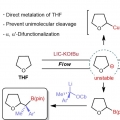
Direct C–H metallation of tetrahydrofuran and application in flow
The direct C–H metallation of tetrahydrofuran (THF) to generate α-anionic THF is one of the most straightforward methods for the the generation and utilization of α-anionic THF. Here we develop a reaction for the direct me... -
Read More
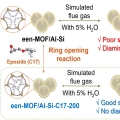
Functionalization of Diamine-Appended MOF-Based Adsorbents by Ring Opening of Epoxide: Long-Term Stability and CO2 Recyclability under Humid Conditions
Although diamine-appended metal-organic framework (MOF) adsorbents exhibit excellent CO2 adsorption performance, a continuous decrease in long-term capacity during repeated wet cycles remains a formidable challenge for practical application... -
Read More
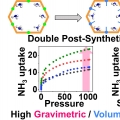
High Gravimetric and Volumetric Ammonia Capacities in Robust Metal–Organic Frameworks Prepared via Double Postsynthetic Modification
Ammonia is a promising energy vector that can store the high energy density of hydrogen. For this reason, numerous adsorbents have been investigated as ammonia storage materials, but ammonia adsorbents with a high gravimetric/volumetric amm... -
Read More
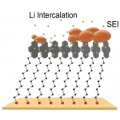
Li-ion Intercalation, Rectification, and Solid Electrolyte Interphase in Molecular Tunnel Junctions
This paper describes Li-ion intercalation into pyrenyl terminated self-assembled monolayer (SAM) on gold, inspired from graphite anode in Li-ion battery, and its effect on tunneling performance in molecular junction incorporating the SAM. A... -
Read More
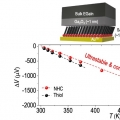
Thermopower of Molecular Junction in Harsh Thermal Environments
Molecular junctions can be miniaturized devices for heat-to-electricity conversion application, yet these operate only in mild thermal environments (less than 323 K) because thiol, the most widely used anchor moiety for chemisorption of act... -
Read More

Microfluidics-Assisted Synthesis of Hierarchical Cu2O Nanocrystal as C2-Selective CO2 Reduction Electrocatalyst
Copper-based catalysts have attracted enormous attention due to their high selectivity for C2+ products during the electrochemical reduction of CO2 (CO2RR). In particular, grain boundaries on the catalysts contribute to the generation of va... -
Read More

Chemical Fields: Directing Atom Migration in the Multiphasic Nanocrystal
Atoms in a bulk solid phase are usually trapped to fixed positions and can change their position only under certain conditions (e.g., at a melting point) due to the high energy barrier of migration between positions within the crystal latti... -
Read More
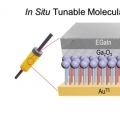
Electronic Mechanism of In Situ Inversion of Rectification Polarity in Supramolecular Engineered Monolayer
This paper describes polarity inversion in molecular rectification and the related mechanism. Using supramolecular engineered, ultrastable binary mixed self-assembled monolayer (SAM) composed of organic molecular diode (SC11BIPY) and inert ... -
Read More
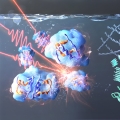
Direct observation of protein structural transitions through entire amyloid aggregation processes in water using 2D-IR spectroscopy
Amyloid proteins that undergo self-assembly to form insoluble fibrillar aggregates have attracted much attention due to their role in biological and pathological significance in amyloidosis. This study aims to understand the amyloid aggrega... -
Read More

Harnessing GLUT1-Targeted Pro-oxidant Ascorbate for Synergistic Phototherapeutics
Despite extensive efforts to realize effective photodynamic therapy (PDT), there is still a lack of therapeutic approaches concisely structured to mitigate the major obstacles of PDT in clinical applications. Herein, we report a molecular s... -
Read More
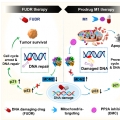
DNA-Damage-Response-Targeting Mitochondria-Activated Multifunctional Prodrug Strategy for Self-Defensive Tumor Therapy
We report a novel multifunctional construct, M1, designed explicitly to target the DNA damage response in cancer cells. M1 contains both a floxuridine (FUDR) and protein phosphatase 2A (PP2A) inhibitor combined with a GSH-sensitive linker. ... -
Read More

Midwavelength Infrared Colloidal Nanowire Laser
Realizing bright colloidal infrared emitters in the midwavelength infrared (or mid-IR), which can be used for low-power IR light-emitting diodes (LEDs), sensors, and deep-tissue imaging, has been a challenge for the last few decades. Here, ... -
Read More
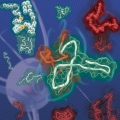
Kinetic Modulation of Amyloid-β (1–42) Aggregation and Toxicity by Structure-Based Rational Design
임동준 (제1저자, 통합과정생) Several point mutations can modulate protein structure and dynamics, leading to different natures. Especially in the case of amyloidogenic proteins closely related to neurodegenerative diseases, structural chang... -
Read More

Safeguarding the RuO2 phase against lattice oxygen oxidation during acidic water electrooxidation
Defective RuO2 possesses excellent initial activity toward the oxygen evolution reaction in acidic water electrooxidation due to the involvement of lattice oxygens, which, however, is the very reason for the accelerated dissolution of Ru sp... -
Read More
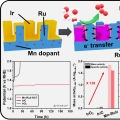
Mn-dopant differentiating the Ru and Ir oxidation states in catalytic oxides toward durable oxygen evolution reaction in acidic electrolyte
Designing an efficient and durable electrocatalyst for the sluggish oxygen evolution reaction (OER) at the anode remains the foremost challenge in developing proton exchange membrane (PEM) electrolyzers. Here we report a highly active and d... -
Read More

Dynamic Water Promotes Lithium-Ion Transport in Superconcentrated and Eutectic Aqueous Electrolytes
김준규(제1저자, 통합과정) Superconcentrated aqueous electrolytes have shown promise as safe and high-voltage lithium-ion battery (LIB) electrolytes. However, the interplay of lithium-ion solvation structure and dynamics with fast Li-ion tra... -
Read More
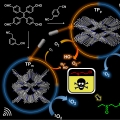
Isomeric sp2-C conjugated Porous Organic Polymer-mediated Photo- and Sono-catalytic Detoxification of Sulfur Mustard Simulant under Ambient Conditions
The development of efficient strategies for the sustainable detoxification of mustard gas simulants has longstanding demand for human safety. Here, we present for the first time a photo- and sono-catalyzed selective detoxification of mustar... -
Read More

Vertical-crystalline Fe-doped β-Ni oxyhydroxides for highly active and stable oxygen evolution reaction
김병윤 (제1저자, 기초과학연구원) The layered transition metal oxyhydroxides have received increasing interest owing to the efficient energy conversion performance and material stability during the oxygen evolution reaction (OER). In particu... -
Read More
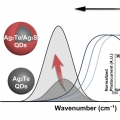
Extended Short-Wavelength Infrared Photoluminescence and Photocurrent of Nonstoichiometric Silver Telluride Colloidal Nanocrystals
김가현(제1저자, 석박통합과정) Demands on nontoxic nanomaterials in the short-wavelength infrared (SWIR) have rapidly grown over the past decade. Here, we present the nonstoichiometric silver chalcogenide nanocrystals of AgxTe (x > 2) and Ag... -
Read More
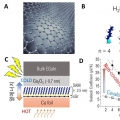
Enhanced Thermopower of Saturated Molecules by Noncovalent Anchor-Induced Electron Doping of Single-Layer Graphene Electrode
Enhancing thermopower is a key goal in organic and molecular thermoelectrics. Herein, it is shown that introducing noncovalent contact with a single-layer graphene (SLG) electrode improves the thermopower of saturated molecules as compared ...

